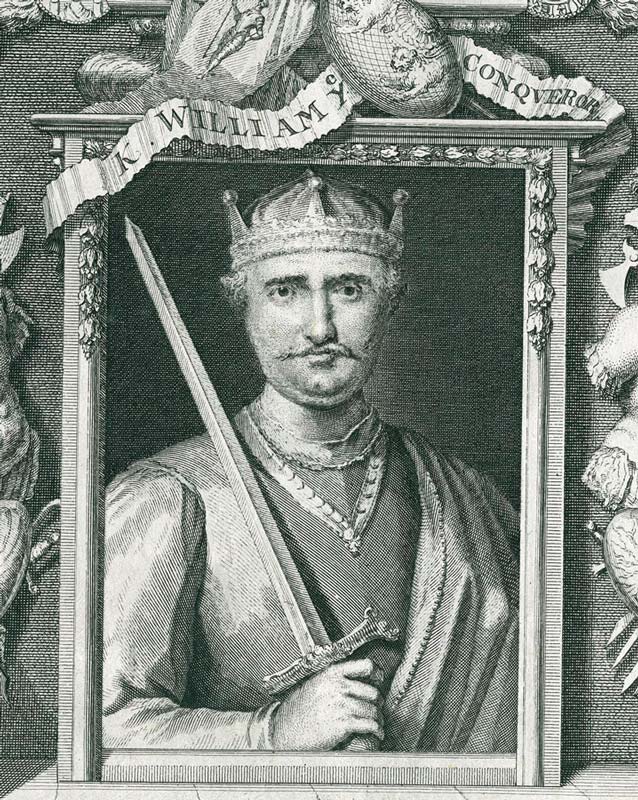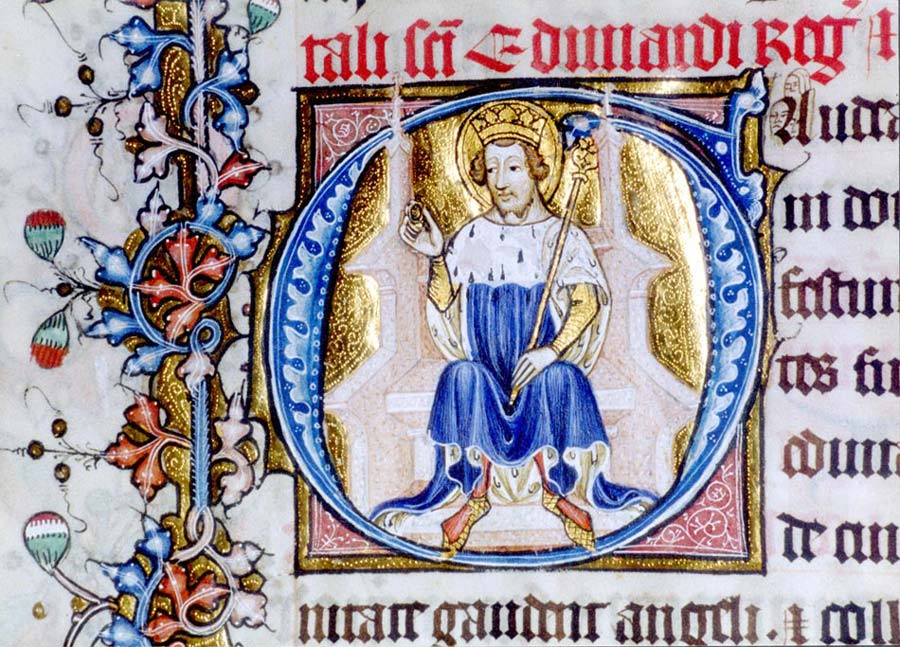Henry V and Catherine de Valois
Henry was born in Monmouth Castle, eldest son of Henry IV and Mary de Bohun. The date of his birth in many biographies is given as 16th December 1387 but now historians agree that it was on 16th September 1386.
He succeeded his father in 1413. His life and reign, especially his conquests in France, are well known. A Te Deum for the victory of Agincourt, fought on St Crispin's Day, 25th October 1415, was sung before the shrine of St Edward the Confessor in the Abbey and Henry contributed money yearly towards the rebuilding of the Abbey nave.
His figure is shown in a modern stained glass window on the north side of the nave (a memorial to Lord Kelvin).
Marriage
He married Catherine de Valois, daughter of Charles VI of France, at Troyes on 2nd June 1420.
Coronation
This took place in the Abbey on 9th April 1413. Snow fell on the day of the ceremony and this was taken by some to mean there were hard times ahead. A jewel now in the Imperial State Crown may have been one he wore in his helmet at Agincourt in 1415. Two carvings depicting his coronation appear on his Chantry Chapel.
Burial and Monument
On 31st August 1422 Henry died at Vincennes in France and his body was embalmed and rested for a time in Rouen Cathedral. He was returned to England and a great procession accompanied the cortege from Dover to St Paul's Cathedral in London. The coffin, on which lay his funeral effigy (which does not survive), was then brought to the Abbey on 7th November 1422 for burial.
At his magnificent funeral four horses drew the chariot into the Nave as far as the choir screen. Henry had directed that a chantry chapel should be raised over his body at the eastern end of St Edward the Confessor's chapel. His tomb was completed in about 1431 and the Chantry was built between 1437 and 1450. This was supervised by John Thirske and encroaches on the tombs of Eleanor of Castile and Philippa of Hainault in the Confessor's chapel. Originally there were tall railings guarding the east end of the tomb (taken down in 1821 and now in the Abbey's reserve collection). The present grate at the west end of the tomb dates from the reign of Henry VII (the original one by Roger Johnson having been sold).
The inscription around the ledge of the tomb platform can be translated:
Henry V, hammer of the Gauls, lies here. Henry was put in the urn 1422. Virtue conquers all. The fair Catherine finally joined her husband 1437. Flee idleness.
The effigy head, hands, sceptres and other regalia were all of silver, with silver gilt plates covering the figure of the king. Some ornaments, such as the angels at the head of the effigy, the lions at his feet, two sceptres he was holding (one with a cross and one with a dove, as used at a coronation ceremony) and part of his crown, disappeared between 1467 and 1479 according to Abbey inventories. All the rest of the silver was stolen by night in 1546 and the effigy was just a plain block of oak for many centuries.
In 1971 a new head, hands and a crown for the effigy were modelled in polyester resin by Louisa Bolt, the features following a contemporary description of the king and the earliest portrait of him. These hands hold just the bases of the sceptres.
The tomb lies beneath the arch of the chantry, which is carved with figures of kings and saints. Above him is the Altar of the Annunciation, where prayers were said for the soul of the king. As well as the two Annunciation images above the altar are also statues of St George, St Denys, St Edward the Confessor and St Edmund. The centre niche is now empty but probably contained a representation of the Trinity.
On the bridges spanning the ambulatories are sculptures depicting Henry at his coronation and riding into battle on his horse. Among heraldic devices on the vault above his tomb and the bridges are a cresset (or beacon), a collared antelope and a collared swan chained to a beacon.
Tomb dimensions in metres: length 2.24. width 1.07. height 1.60.
Funeral Achievements
The saddle, helm and shield, which were part of his funeral 'achievements', were for many centuries kept in the chantry or displayed on the wooden beam above, but were restored and removed for better preservation to the Abbey Museum in 1972.
This saddle is the earliest surviving example of a new light-weight type, originally covered with blue velvet. The lime wood shield has a small section of crimson velvet remaining on the inner side, showing the arms of Navarre (Joan of Navarre was his stepmother, so this shield may have belonged to Henry IV). The front of the shield had been painted with the arms of France and England and faint traces of blue paint still remain. The five-section domed helm, about sixteen inches high, with an applied decorated band of copper alloy round the bottom edge, is a tilting (jousting) helm so would not have been worn in battle. This weighs 7.3kg.
A finely balanced 15th century sword with a cross of St George in the pommel, found in the Abbey triforium in 1869, was thought for many years to be part of this funeral armour. Recent research shows this to be a sword later than the time of Henry V, possibly from Henry VII's time.
Catherine de Valois
Henry's widow Catherine de Valois (1401-1437) married Owen Tudor, a Welsh squire, and one of her three sons, Edmund, Earl of Richmond was the father of the future Henry VII. Her funeral took place on 10th February 1437. Solemn vespers for the dead were sung on the eve of the funeral. Many nobles, with the king and queen, attended the funeral when fifty nine cloths of gold were offered at the mass (thirty seven having been given at the dirge) for the use of the Abbey sacristy (none of which remain). Her painted wooden funeral effigy on the hearse was robed in a satin mantle, surcote and tunic, all furred with ermine. Crown, sceptre and rings were all of silver-gilt. She was buried in the old Lady chapel and when Henry VII pulled this down to build his new chapel he moved his grandmother's coffin. Her body was then placed above ground within the railings beside Henry V's tomb, in an open coffin of loose boards. There it remained for nearly 300 years. Samuel Pepys, the famous diarist, saw the mummified remains in 1669 and records how he was allowed to kiss the queen!
The coffin was eventually moved and buried in 1778 within a vault under St Nicholas's chapel and a century later Dean Stanley removed her remains for permanent burial under the new altar he had erected in Henry V's chantry. The inscription for her on the altar can be translated:
Under this slab (once the altar of this chapel) for long cast down and broken up by fire, rest at last, after various vicissitudes, finally deposited here by command of Queen Victoria, the bones of Catherine de Valois, daughter of Charles VI, King of France, wife of Henry V, mother of Henry VI, grandmother of Henry VII, born 1400, crowned 1421, died 1438.
The date 1878 is given in the bottom corner, when the remains were buried, together with a coat of arms and three badges of Henry V within trefoils: a beacon, an antelope and a swan. The date of death is incorrect.
Her wooden funeral effigy still survives in the Abbey collection.
Henry's brother in law, Louis (Ludwig) III, Count Palatine of the Rhine (1378-1436) Duke of Bavaria, had his funeral at the Abbey.
A service of Evensong to commemorate the 600th anniversary of his death will be held in the Abbey on 8th November 2022.
Further reading
Queens Consort of Westminster Abbey
The funeral effigy and armour items are on display in the Abbey's Queen's Diamond Jubilee Galleries
A service to commemorate the anniversary of the battle of Agincourt was held in the Abbey on 29th October 2015
A conference was held at Westminster School on 28th October 2015 discussing aspects of his funeral and the armour. These detailed papers have been published in The Funeral Achievements of Henry V at Westminster Abbey edited by A.Curry and S.Jenkins, October 2022.
Henry V. A biography by H. Hutchison, 1967
The reign of Henry V by J.H. Wylie, 3 vols, 1914-29
The funeral, monument and chantry chapel of Henry V by W. St John Hope in Archaeologia vol. LXV, 1914
The funeral effigies of Westminster Abbey edited by A. Harvey & R. Mortimer, revised edn. 2003
Royal wooden funeral effigies at Westminster Abbey by S. Jenkins and K. Blessley, Burlington Magazine Jan. 2019 vol.161
A sword...in Westminster Abbey by J.G. Mann in Antiquaries Journal, 1931
A fifteenth century century sword...from Westminster Abbey by L.E. Tanner in Antiquaries Journal, 1930
A helm, shield and sword associated with the funeral of Henry V by Claude Blair in Gothic Art for England.., Victoria & Albert Museum exhibition catalogue 2003
Textiles from the funerary achievement of Henry V by Lisa Monnas, in Proceedings of the 2001 Harlaxton Symposium edited by J. Stratford, 2003
Oxford Dictionary of National Biography 2004

This image can be purchased from Westminster Abbey Library
Image © 2024 Dean and Chapter of Westminster

This image can be purchased from Westminster Abbey Library
Image © 2024 Dean and Chapter of Westminster

This image can be purchased from Westminster Abbey Library
Image © 2024 Dean and Chapter of Westminster

This image can be purchased from Westminster Abbey Library
Image © 2024 Dean and Chapter of Westminster

This image can be purchased from Westminster Abbey Library
Image © 2024 Dean and Chapter of Westminster

This image can be purchased from Westminster Abbey Library
Image © 2024 Dean and Chapter of Westminster

This image can be purchased from Westminster Abbey Library
Image © 2024 Dean and Chapter of Westminster










